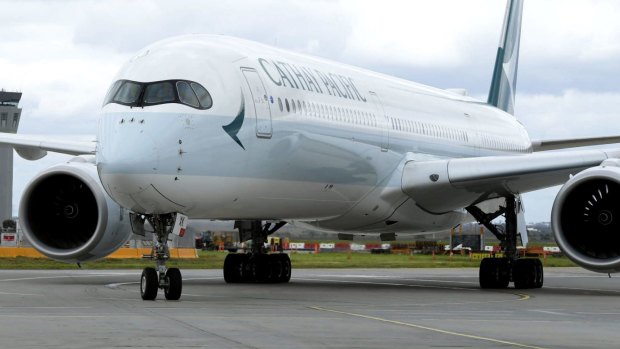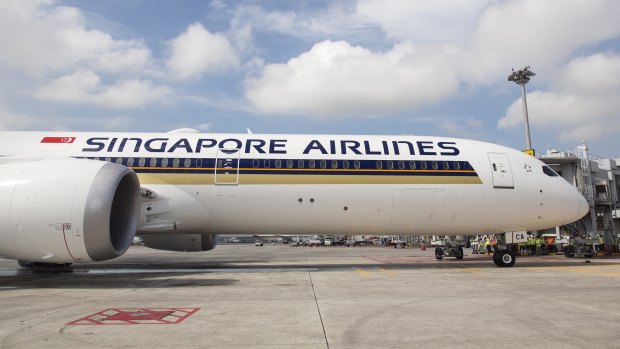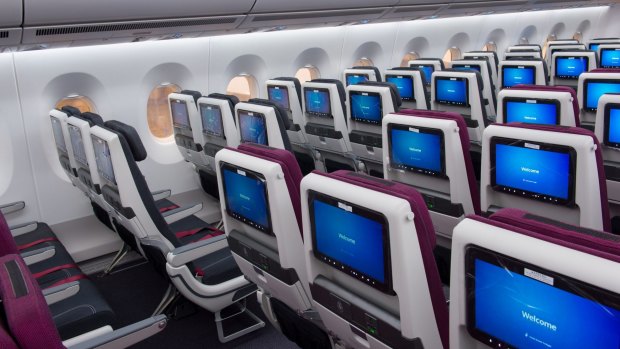This was published 4 years ago
Which airlines fly Airbus A350s or Boeing 787 Dreamliners to Australia?
By Michael Gebicki

Cathay Pacific recently became the first airline to bring the A350-1000 to Australia.
Most flyers love a shiny new aircraft type, and the latest to be seen in our skies are the Airbus A350-1000 and Boeing's 787-10 Dreamliner.
Australia's airports have already seen plenty of Airbus A350s and Boeing 787 Dreamliners, but not so these latest iterations of both aircraft. Boeing 787-10 launch customer Singapore Airlines began operating the 787-10 on its Singapore-Perth service only in May 2018.
More recently, EVA Air became the first to operate a Boeing 787-10 service to an east coast Australian airport when flight BR315 from Taipei touched down at Brisbane International Airport on October 8, 2019. Close on its heels came the latest and biggest variant of the A350 tribe, the Airbus A350-1000. On October 27, 2019, after a nine-hour flight from Hong Kong, Cathay Pacific became the first airline to land an A350-1000 here when CX105 touched down in Melbourne.

Singapore Airlines operates the Boeing 787-10 Dreamliner on its Perth-Singapore route.Credit: Bloomberg
Characteristics of both aircraft
They're both twin-engine, twin-aisle long-range aircraft. Both are constructed extensively from carbon fibre reinforced polymer (CFRP). One of the big advantages, CFRP is better able to withstand the pressures of expansion and contraction caused by operating between sea level and high altitude. This means a longer-lasting airframe and also one that can tolerate higher pressure inside the cabin.
Cabin pressure for both aircraft is equivalent to about 1800 metres, some 600 metres lower than in a conventional aircraft cabin. For passengers that means more air in your lungs, and possibly a more comfortable flight.

Qatar Airways economy class on the A350-1000. Cabin pressure for both the A350 and the Dreamliner is closer to ground-level pressure, making flights more comfortable.
The vital statistics
In a two-class configuration the Boeing 787-10 carries 330 passengers while the Airbus A350-100 carries between 366 and 369. Both cruise at the same speed, 903 kph, but the A350 has a much greater range, 15,600 km as against the Boeing's 11,910 km.
The A350-1000 is slightly longer than the Boeing 787-10, 73.78 metres compared to 68.28 metres. It also has longer wings, a wider cabin, greater cargo carrying capacity, carries considerably more fuel and has more powerful engines.
However, the Boeing 787 is known to be the most fuel-efficient aircraft in the skies. A 2013 study that compared the Boeing 787-9 with the Airbus A350-900 found that the fuel consumption per passenger for the Boeing was 2.8 litres per 100km, against 3.08 litres per 100km for the Airbus.
In 2018, the Boeing 787-10 was priced at $US325.8 million ($A479.9 million) while the A350-1000 cost $US366.5 million ($539.8 million). That mirrors the price difference between previous versions of both aircraft, and that's the main reason there are more Boeing 787 Dreamliners in the skies than Airbus A350s.
Both the Boeing 787 and the Airbus A350 have loyal supporters. While they might argue over the merits of turbulence avoidance systems and noise-reducing chevrons on the engine nacelles, in terms of the passenger flight experience there's little difference between them.
Some might prefer the slightly more generous dimensions of the Airbus, some the technical refinements of the Boeing, but those passengers who express a strong preference for one or the other mostly do so out of brand loyalty – and possibly out of nationalistic pride.
However, there are a few small differences that can become important, and possibly irritating when you're locked into a pressure-sealed vessel for many hours at a time.
Windows
The 787 has the largest windows of any commercial aircraft. This is a plus for passengers, although some take issue with the electrically dimmable windows that have replaced the conventional pull-down window shades.
These windows contain an electrified gel sandwiched between two thin pieces of glass. As the electric current increases, the gel darkens and as it drops, the gel lightens. Passengers can control the darkening effect of their individual windows, but cabin crew can override that control. The crew can and do dim the windows when it suits them, making it impossible for passengers to see what's happening outside.
See also: The scary reason plane windows are round, not square
Cabin air supply
In commercial aircraft the air that is supplied to the cabin is known as bleed air, drawn from the engine before the compressor stage. It can sometimes happen that lubricating oil seeps through seals in the engine and contaminates this supply, adding a potentially toxic element to the air that enters the cabin.
Breathing this air can cause a condition known as aerotoxic syndrome, and although many aircrew and passengers have reported symptoms associated with aerotoxicity, airlines and regulatory authorities continue to deny its existence. The 787 uses non-bleed air, neatly sidestepping the issue.
See: The most dangerous thing about flying can be the air you're breathing
Cabin noise
According to Airbus, at cruise altitude noise inside the A350 cabin, at 57 decibels, is five decibels quieter than the Boeing 787. That's a small difference that you'd only notice if you were to do a side-by side comparison, and that's not possible. In any case the advantage of flying in the slightly quieter cabin of the A350 could easily be negated if you were in close proximity to shouty passengers, or a noisy infant.
The airlines flying the Boeing 787 to and from Australia
- Air Canada
- American Airlines
- Air NZ
- ANA
- Etihad
- Japan Airlines
- Jetstar
- Korean Air
- LATAM
- Qantas
- Qatar Airways
- Royal Brunei
- Scoot
- Singapore Airlines
- United
- Vietnam Airlines
- Xiamen
The airlines flying the Airbus A350 to and from Australia
- Cathay Pacific
- China Airlines
- China Eastern
- Fiji Airways (starting December 1)
- Qatar Airways
- Singapore Airlines
- Thai Airways
- Vietnam Airlines
Have you flown on a Boeing 787 or Airbus A350? Which aircraft do you prefer? Post your comments below.
See also: Hour by hour: My epic non-stop Qantas flight from London
See also: Retiring 747 breaks record for shortest ever jumbo flight
Sign up for the Traveller newsletter
The latest travel news, tips and inspiration delivered to your inbox. Sign up now.